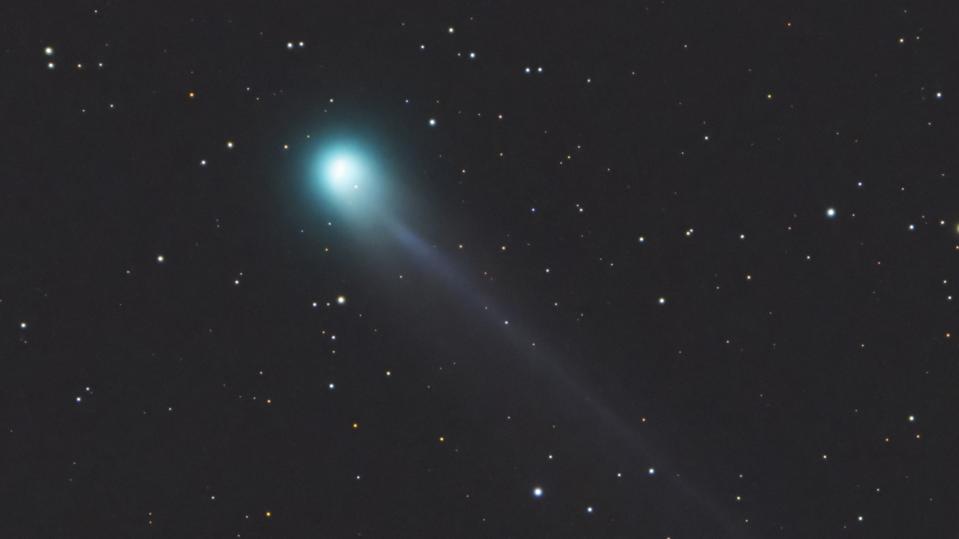Topline
If you’re yet to see Comet Lemmon (C/2025 A6) and Comet SWAN (C/2025 R2), here comes a final easy chance before they get drowned out by strong moonlight. With the moon approaching its half-lit, first quarter phase on Wednesday, Oct. 28, 2025, these icy visitors from the edge of the solar system will become harder to find with binoculars and transition to telescopic objects. Visible in the northeast and south, respectively, Lemmon and SWAN are now in their post-closest approach phase and drifting farther from Earth, with Lemmon closing in on its perihelion on Nov. 8, when it will swing closest to the sun.
Key Facts
Comet Lemmon can be found west of the Big Dipper, beyond bright star Arcturus, while Comet SWAN is moving towards Saturn, and is presently beneath Altair, the bright star at the tip of the famous Summer Triangle. The best time to look is 90 minutes after sunset.
If you want the best view, use 8×42 or 10×50 binoculars from a Dark Sky Place or somewhere that appears dark on a light pollution map.
Use stargazing apps such as Sky Guide, Stellarium and SkySafari to find the comets, or finder charts at In-The-Sky.com.
Comet Lemmon was discovered on Jan. 3, 2025, by the Mount Lemmon Survey near Tucson, Arizona, and will reach its closest point to the Sun on Nov. 8. It will return to the inner solar system in about 1,150 years.
Comet SWAN was found on Sept. 11, 2025, as it looped around the sun. Lemmon last visited the inner solar system in AD 875 and will return around 3175, while SWAN takes roughly 20,000 years to complete one orbit.
When And Where To See The Comets
The best time to spot Comet Lemmon and Comet SWAN on Wednesday, Oct. 29, is during a 30-minute window starting about 90 minutes after sunset where you are. Both are visible after sunset but in opposite parts of the sky — Lemmon in the northwest, SWAN in the southwest. For New York City, where sunset is at 5:52 p.m. EDT, the ideal time for evening viewing is 7:22-7:52 p.m. EDT.
How To Find Comet Lemmon
Distance from the Sun: 54.9 million miles (88.4 million kilometers)
Distance from Earth: 63.5 million miles (102.2 million kilometers)
After sunset on Wednesday, Oct. 29, look for Comet Lemmon due west in the constellation Serpens, “The Serpent.” It will be above and left of the bright star Arcturus. Use bright star Vega, high up above the west, to guide you to Comet Lemmon, directly below. The comet’s height above the horizon varies by location, but from New York, the comet will appear about 20 degrees up at 7:22 p.m. EDT and will gradually sink as twilight deepens.
How To Find Comet Swan
Distance from the sun: 106 million miles (170.6 million kilometers)
Distance from Earth: 31.2 million miles (50.2 million kilometers)
Blueish-green Comet SWAN will be visible in binoculars on Wednesday, Oct.29, low in the south after sunset. SWAN will be in the constellation Aquarius, below and to the left of the bright star Altair in the Summer Triangle. You’ll find it between Altair and Fomalhaut, a bright star closer to the horizon. However, the presence of a bright moon to SWAN’s lower left will make finding it difficult. The comet’s height above the horizon will vary depending on your location, but from New York, it will be around 46 degrees up as it becomes visible.
Check my feed every day this month for a daily “comet tracker” with finder charts and tips for viewing Comet Lemmon and Comet SWAN from mid-northern latitudes. Also read How To Photograph The Green Comets, Best Stargazing Apps For Finding The Comets and 25 Dark Sky Parks In The U.S. To See The Comets.

